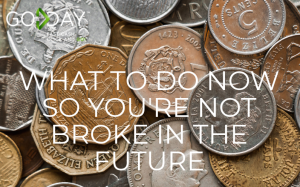
We’re all about living in the moment and enjoying your life for what it is today. However, one of the biggest things that people do is spend too much time living in the moment that they forget about their future. Whether it’s wanting to go to university, wanting a new car, having kids, getting married, or whatever your long-term goals are in life, it’s important to plan for your future now so you can not just make your short-term goals come to life, but also your long-term ones.
So how can you strike a balance between the two? Here is some advice:
Know what you’re saving for
This is a big one. It can be hard to know exactly where your path is going to take you, but knowing what your money is being saved for helps. For example, a long-term goal may be that you want to reach financial independence at age 60 so you no longer need to work to live and enjoy life. In that case, you may want to look at starting an RRSP and figuring out how much you can contribute now, and how much you need to contribute to reach your desired retirement amount.
This can seem daunting, especially when you’re young, so that’s why it’s important to also have short-term goals too. This can be anything from paying off your student loans or debt, buying a new car or home, going on your dream trip to Africa, the list goes on. Once you have these, write them down, and figure out how much you’ll need to make those goals happen, and how you’re going to get there step-by-step.
Create a budget
Having a budget and understanding your cash flow is going to be one of the most important things to help you determine your financial future. If you want more money to spend now or down the line, you’re going to need to understand where your current money is going to and coming from. Do this by tracking how much you are spending weekly and what you’re spending it on. Apps like Mint can really help make this process easy.
As you begin to track and take a hard look at your spendings and savings, you’ll soon realize where you are overspending. This will help you prioritize what’s important to you and have more control over your money, both in the short and long-term.
Start a savings account
When you’re putting all your money into one account, it can be easy to spend it on whatever, whenever. However, if your “savings” are sitting in that same account, it’s hard to know what you are saving, versus what you should be spending. That’s why it’s important to keep your savings separate.
There are different types of accounts out there that you can open to help you save money. Tax-free savings accounts (TFSA) is a way for people to set money aside tax-free throughout your life. Meaning that contributions to this account are not deductible and any amount contributed, as well as income earned in the account (like from investments for example), is generally tax-free. Registered retirement savings plans (RRSP) are great for saving for retirement or bigger purchases in your life like a house, since taking money in and out of this account isn’t always the easiest. Contributions to these accounts can also be claimed on your income tax and can help reduce the amount of tax you owe during tax season!
Figuring out how and what to save for your future can be daunting, but if you have goals you want to achieve in your life that involve having money, you’re going to need to take a hard look on how you’re going to get yourself there. Even though saving for retirement doesn’t seem like the most exciting way to spend your money when you’re 40-50 years away from it, it’s something that you aren’t going to regret having as a cushion when you decide it’s time to retire. And remember, even if you can only afford to save a little bit of cash each paycheque, a little bit can go a long way!


